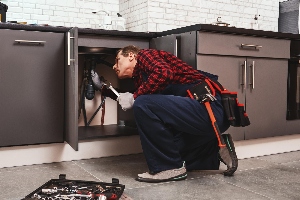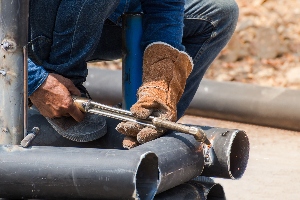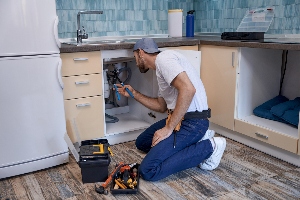Low water pressure can turn everyday tasks. Are you noticing weaker water flow from your faucets lately? Summer heat can sometimes lead to lower water pressure in homes across neighborhoods.
This common issue might be frustrating when you're trying to shower, wash dishes, or water your garden.
To increase your water pressure, you can adjust the pressure regulator by turning the screw at the tip to tighten it.
This simple fix often solves the problem without calling a plumber. Before making adjustments, it's worth checking for leaks by walking around your property and looking for wet spots between your water meter and house.
We recommend also checking if your neighbors are experiencing similar issues, as seasonal changes can affect water pressure throughout your area. If adjusting the regulator doesn't help, you might want to inspect your pipes for clogs or consider if your home needs a pressure booster system.
In this guide, we’ll break down why water pressure drops in summer, how to troubleshoot the issue room by room, and what steps you can take to fix it, on your own or with the help of a pro.
Here's what you need to know:
- Why low water pressure happens in summer
- Water pressure troubleshooting: how to diagnose the problem
- Effective solutions to improve summer water pressure
- Advanced water pressure fixes (and when to call a plumber)
From clogged pipes to faulty pressure regulators, the right solution starts with the right diagnosis.
Why low water pressure happens in summer
Summer brings specific challenges to home water systems that can leave you with frustratingly weak showers and slow-filling pools. Water pressure issues tend to worsen during hot months due to increased demand and environmental factors.
Common causes of low water pressure at home
Low water pressure in summer often stems from neighborhood-wide usage spikes. When everyone waters lawns or fills pools simultaneously, the municipal supply gets stretched thin. This creates a noticeable drop in residential water pressure throughout entire communities.
Clogged pipes and fixtures represent another common culprit. Mineral deposits build up over time, narrowing the path for water flow. Check your faucet aerators and showerheads for white crusty buildup - this often explains why individual fixtures have poor performance.
Aging infrastructure, both in public systems and inside your home, can deteriorate and restrict water movement. Pipes corrode, creating rough inner surfaces that slow water flow significantly.
Leaks waste water before it reaches your fixtures. Even small hidden leaks can reduce your overall pressure by diverting water where you don't want it.
How hot weather and summer usage reduce water
Hot weather directly affects your water system's performance. Higher temperatures cause increased water evaporation in municipal reservoirs, sometimes leading to lower available volume.
Water suppliers often reduce pressure during summer drought conditions to conserve resources. This practice helps maintain adequate supply but results in weaker flow at your taps.
Peak usage times become more pronounced in summer. Try to avoid running water between 6-9 AM and 5-8 PM when demand is highest. You'll likely experience better pressure during off-peak hours.
Many households install irrigation systems that activate during summer months. These systems demand substantial water volume, potentially dropping your household pressure when operating.
Signs your home has a water pressure issue
The most obvious indicator is weak water flow from multiple fixtures. If your shower feels more like a drizzle than a satisfying spray, you're experiencing low pressure issues.
Use a pressure gauge connected to an outside spigot to get an accurate reading. Residential water pressure typically measures between 40-60 psi. Readings below 40 psi confirm a pressure problem.
Appliances will show telltale signs too. Dishwashers and washing machines may take longer to fill or operate less effectively with insufficient water pressure.
Inconsistent pressure - strong in some areas but weak in others - often points to localized problems like clogged pipes rather than a whole-house issue. This pattern helps narrow down potential causes.
Water pressure troubleshooting: how to diagnose the problem
Finding the source of low water pressure requires a systematic approach to check various components of your plumbing system. The right diagnosis will lead to the most effective solution.
How to check fixtures for low water pressure
Start by testing multiple water fixtures throughout your home. Turn on faucets one by one to see if the problem affects your entire house or just specific areas.
Remove and inspect faucet aerators and showerheads for mineral buildup. These small screens can collect sediment and lime deposits that restrict water flow. Soak them in vinegar for a few hours to dissolve deposits.
If only hot water pressure is low, check your water heater. The problem might be with the shut-off valve or internal components.
For homes with well pumps, verify the pump is functioning properly. A failing well pump often causes pressure to gradually decrease throughout the house.
How to test water pressure using a gauge
A pressure gauge is an essential tool for accurate diagnosis. Purchase an inexpensive gauge from a hardware store that attaches to an outdoor spigot.
How to test your water pressure:
- Attach the gauge to an outdoor hose bib
- Make sure no water is running in the house
- Turn on the spigot fully
- Read the measurement on the gauge
Normal residential water pressure typically ranges from 40-80 psi. Readings below 40 psi indicate low pressure that needs addressing.
Test at different times of day. Water pressure often drops during peak usage times in your neighborhood. This helps determine if the issue is with your home or the municipal supply.
Inspecting pipes for clogs and corrosion
Older homes with galvanized piping are prone to internal corrosion that restricts water flow. Check exposed pipes for signs of corrosion, which appears as bumpy textures or discoloration.
Look for obvious obstructions in visible plumbing. Tree roots can infiltrate underground pipes, while mineral deposits build up inside pipes over time.
Listen for unusual sounds when water runs. Gurgling or knocking might indicate a clog or air in the lines.
Check for leaks, as they reduce pressure before water reaches your fixtures. Even small leaks can significantly impact water pressure throughout your home.
According to the EPA, household leaks can waste nearly 10,000 gallons of water per year, not only driving up your water bill but also contributing to chronic low water pressure if left unaddressed.
Pressure regulator issues: how to inspect and adjust
Locate your main shutoff valve, usually near the water meter. Ensure it's fully open, as a partially closed valve drastically reduces pressure. The valve handle should be parallel to the pipe when fully open.
If your home has a pressure regulator (typically a bell-shaped device near the main water line), it might need adjustment or replacement. These devices can fail over time or be set too low.
Check the water meter valve as well. Sometimes municipal workers don't fully reopen these valves after maintenance.
For multi-story homes, pressure might be insufficient for upper floors. Consider if you need a pressure booster system, especially if pressure is adequate on lower levels but weak upstairs.
Effective solutions to improve summer water pressure
Low water pressure can ruin summer activities from gardening to showering after a hot day. We've identified several practical fixes that can help boost your water flow without calling in expensive professionals.
How to remove buildup and restore water pressure
Mineral deposits and debris often accumulate in pipes and fixtures, restricting water flow. Start by checking your faucet aerators - unscrew them and rinse away any visible buildup. Soaking aerators in vinegar overnight can dissolve stubborn mineral deposits.
Showerheads frequently collect minerals, especially in hard water areas. Remove yours and soak it in vinegar for 30 minutes, then scrub with an old toothbrush to clear the tiny holes.
For whole-house issues, consider flushing your plumbing system. Turn off the main water supply, open all faucets, and then turn the water back on to force debris through the pipes.
Hot water heaters can collect sediment that reduces pressure. Drain and flush your water heater annually to prevent buildup and maintain good pressure throughout your home.
Do hard water filters help with low pressure?
Hard water contains high levels of minerals that gradually coat the inside of pipes, narrowing the pathway for water. This restriction becomes more noticeable during summer when water usage increases.
Installing a water softener can prevent future mineral buildup and may improve existing pressure problems. These systems exchange calcium and magnesium ions with sodium, reducing scale formation.
Whole-house filters help trap debris before it enters your plumbing system. Check and replace filters regularly, as clogged filters can dramatically reduce pressure.
For severe cases, consider a sequential filtration system:
- Sediment filter (first stage)
- Carbon filter (second stage)
- Fine particle filter (final stage)
This multi-stage approach ensures clean water while maintaining good pressure throughout your home.
How to adjust or replace your home’s PRV
Many homes have a pressure reducing valve (PRV) installed near the water meter. This device regulates water pressure coming from municipal supply lines into your home. Over time, these valves can fail or need adjustment.
To check your PRV, purchase an inexpensive water pressure gauge from a hardware store. Attach it to an outside faucet and check the reading. Normal household pressure should be between 40-60 psi.
If pressure is below 40 psi, locate your PRV (usually a bell-shaped device) and look for an adjustment screw on top. Turn clockwise in small increments to increase pressure, then retest.
If adjustments don't help or the valve is damaged, replacement may be necessary. While this is a more complex job, a new PRV typically costs $50-$150 plus installation and can dramatically improve water pressure throughout your home.
Advanced water pressure fixes (and when to call a plumber)
When simple DIY fixes don't solve your water pressure problems, it's time to consider more advanced solutions. These options may require specialized equipment or professional expertise to implement properly.
Installing a booster pump or pressure tank
A water pressure booster pump can significantly increase the water pressure throughout your home. These devices connect to your main water line and mechanically increase the pressure of water flowing through your pipes. Most residential booster pumps cost between $300-700, plus installation.
For homes on city water, we recommend consulting with a licensed plumber before installation. They can help determine the right size pump for your needs.
A pressure tank is another option, especially if you experience fluctuating pressure. These tanks store water under pressure and release it when needed, providing more consistent flow throughout your home.
Installation typically requires:
- Cutting into your main water line
- Electrical connections for the pump
- Proper mounting and securing
- Adjusting pressure settings
Low pressure in wells and sprinkler systems: what to do
Well water systems often face unique pressure challenges. If you're on well water, check your well pump first. An aging or undersized pump may struggle to maintain adequate pressure, especially when running sprinklers or multiple fixtures.
Well pump replacement costs typically range from $800-2,000 depending on depth and capacity requirements.
For sprinkler systems, consider:
- Zone-based watering to maintain pressure
- Installing a dedicated pump for your irrigation system
- Adding a larger pressure tank specifically for outdoor use
Smart controllers can help manage water distribution more efficiently by preventing too many sprinklers from running simultaneously.
Upgrading outdated or damaged plumbing
Old galvanized pipes often develop internal corrosion that restricts water flow. Replacing these with copper or PEX piping can dramatically improve pressure throughout your home.
Look for these signs that plumbing upgrades are needed:
- Rusty water coming from faucets
- Inconsistent pressure between hot and cold water
- Pipes that make knocking sounds when water is running
Complete replumbing is a major project costing $2,000-15,000 depending on home size. However, strategic replacement of key sections can sometimes solve pressure issues at a lower cost.
For older homes, consider upgrading your main water line from the street if it's undersized for modern needs. Many older homes have 1/2-inch lines that can be upgraded to 3/4 or 1-inch pipes.
Conclusion
Low water pressure isn’t just inconvenient, it’s a sign your plumbing system needs attention. Whether it’s clogged fixtures, a worn-out pressure regulator, or seasonal strain on your city’s supply, the key is identifying the right cause before small issues turn into major repairs.
By testing your water pressure, inspecting for leaks or buildup, and knowing when to adjust or replace components like your PRV, you can restore strong, consistent flow throughout your home.
And if DIY troubleshooting doesn’t solve it, a licensed plumber can assess your system and recommend long-term solutions like booster pumps or pipe upgrades.
If you’re in the Columbia, SC area and struggling with low water pressure, One Call Plumbing is ready to help. Call us today to get your water flowing right again.












